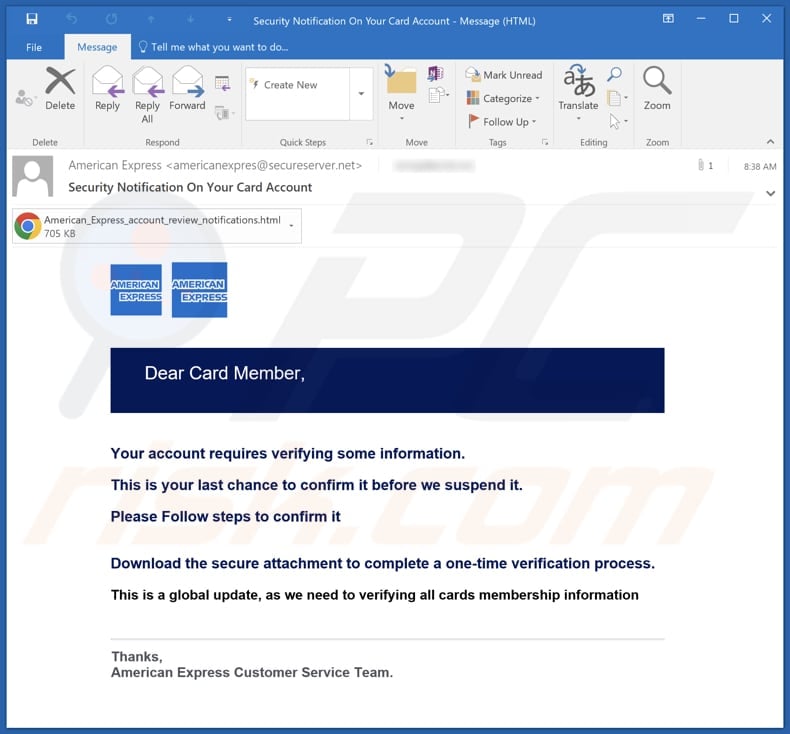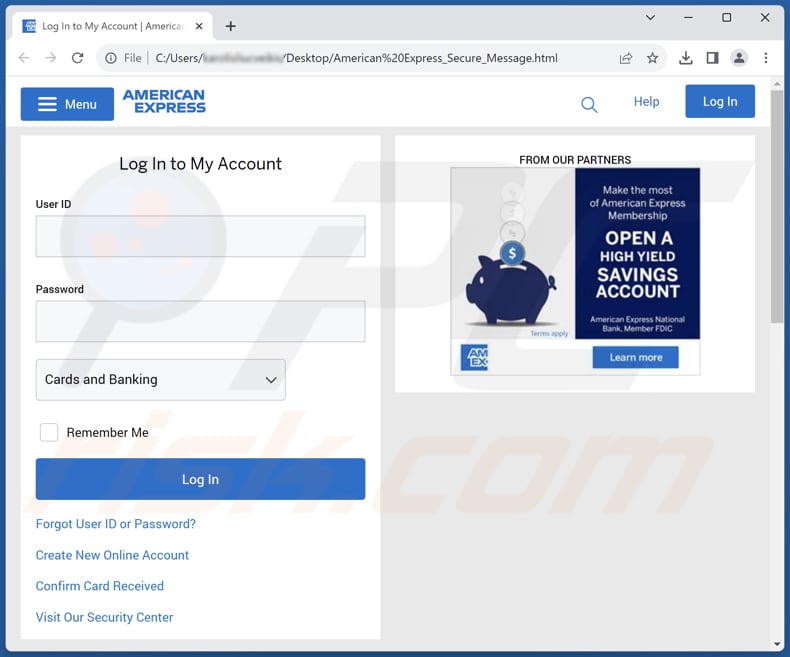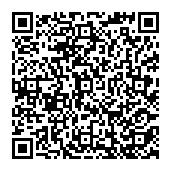How to avoid falling for scams like "American Express Account Confirmation"
![]() Written by Tomas Meskauskas on
Written by Tomas Meskauskas on
What kind of email is "American Express Account Confirmation"?
Upon inspection, the email has been identified as a fraudulent scheme aimed at tricking recipients into disclosing their sensitive information. The scammers impersonate a reputable company, American Express, and promote a phishing website. As a result, it is advisable for recipients to disregard this email.

More about the "American Express Account Confirmation" scam email
In the phishing email with the subject line "Security Notification On Your Card Account", the fraudsters impersonate the American Express Customer Service Team and attempt to deceive recipients into divulging their sensitive information. The email claims that the recipient's account necessitates verification and threatens suspension if not confirmed immediately.
In order to add a veneer of authenticity, the email advises recipients to download a "secure attachment" to complete a one-time verification process. The scammers employ a sense of urgency and fear to manipulate recipients into taking action, emphasizing the importance of this global update. However, the email is a deceptive ploy to harvest personal information.
The attachment in the email, labeled "American_Express_account_review_notifications.html" (though its name may differ), hosts a counterfeit American Express login form. When the attachment is opened, it prompts users to enter their user ID and password, which are then collected by the scammers.
Scammers can misuse stolen American Express user IDs and passwords in several harmful ways. First, they may gain unauthorized access to the victim's American Express account, allowing them to view sensitive financial information, including transaction history and credit card details.
This access enables them to make unauthorized purchases or engage in fraudulent activities using the victim's card, potentially leading to financial losses and disputes. Furthermore, scammers can use the stolen login credentials to perpetrate identity theft.
They may impersonate the victim for various nefarious purposes, such as opening new credit card accounts, applying for loans, or conducting other fraudulent financial transactions in the victim's name. This can result in damaged credit scores, legal complications, and a significant disruption to the victim's financial well-being.
Moreover, scammers might opt to either vend the pilfered login details to third parties or make attempts to breach other accounts by leveraging these credentials.
| Name | American Express Account Confirmation Email Scam |
| Threat Type | Phishing, Scam, Social Engineering, Fraud |
| Fake Claim | Recipient's account account requires verifying information. |
| Attachment | American_Express_account_review_notifications.html |
| Detection Names (Attachment) | Avast (Other:SNH-gen [Phish]), Combo Cleaner (Trojan.GenericKD.70029714), ESET-NOD32 (HTML/Phishing.AmericanExpress.F), Fortinet (JS/Phishing.AMEX!tr), Microsoft (Trojan:HTML/Phish!MSR), Full List Of Detections (VirusTotal) |
| Disguise | Letter from American Express |
| Symptoms | Unauthorized online purchases, changed online account passwords, identity theft, illegal access of the computer. |
| Distribution methods | Deceptive emails, rogue online pop-up ads, search engine poisoning techniques, misspelled domains. |
| Damage | Loss of sensitive private information, monetary loss, identity theft. |
| Malware Removal (Windows) | To eliminate possible malware infections, scan your computer with legitimate antivirus software. Our security researchers recommend using Combo Cleaner. |
Similar scam emails in general
Emails attempting to phish sensitive information often employ a sense of urgency, coercing recipients to take immediate action, such as verifying accounts or resetting passwords. These emails may impersonate trusted organizations, like banks or well-known companies, using logos and formatting to appear legitimate.
They often contain deceptive links or attachments, aiming to either redirect recipients to fake websites or distribute malicious software. Poor grammar, spelling errors, and generic salutations can also be telltale signs of phishing attempts. Some examples of phishing campaigns are "Investment In Your Country", "Adobe Invoice Email Scam", and "Security Information Email Scam".
How do spam campaigns infect computers?
Users can inadvertently infect their computers via email by interacting with malicious attachments or links embedded in deceptive emails. Cybercriminals often send emails containing infected attachments in common file formats like .doc, .pdf, .xls, or .zip, which may execute malware when opened.
These attachments may appear harmless, such as invoices, shipping notifications, or seemingly important documents, luring recipients to click or download them. Similarly, emails distributing malware contain links to fraudulent websites, prompting users to download malicious files or triggering malicious drive-by downloads.
How to avoid installation of malware?
Exercise vigilance when interacting with email attachments or clicking on links, particularly if you are unsure of the source or if the email raises suspicion. It is also imperative to regularly update your operating system, software, and antivirus applications to address known vulnerabilities effectively.
Installing reliable antivirus and anti-malware software can offer an additional shield against potential threats. Practice secure browsing practices by steering clear of dubious websites and refraining from downloading files from sources lacking verification.
Additionally, exercise caution when encountering advertisements, pop-ups, and similar elements on questionable web pages, as these could lead to security risks. If you have already opened malicious attachments, we recommend running a scan with Combo Cleaner Antivirus for Windows to automatically eliminate infiltrated malware.
Text presented in the "American Express Account Confirmation" email letter:
Subject: Security Notification On Your Card Account
Dear Card Member,Your account requires verifying some information.
This is your last chance to confirm it before we suspend it.
Please Follow steps to confirm it
Download the secure attachment to complete a one-time verification process.
This is a global update, as we need to verifying all cards membership information
Thanks,
American Express Customer Service Team.
Screenshot of the fake login form in the attached file ("American_Express_account_review_notifications.html"):

Instant automatic malware removal:
Manual threat removal might be a lengthy and complicated process that requires advanced IT skills. Combo Cleaner is a professional automatic malware removal tool that is recommended to get rid of malware. Download it by clicking the button below:
▼ DOWNLOAD Combo Cleaner
By downloading any software listed on this website you agree to our Privacy Policy and Terms of Use. To use full-featured product, you have to purchase a license for Combo Cleaner. 7 days free trial available. Combo Cleaner is owned and operated by Rcs Lt, the parent company of PCRisk.com read more.
Quick menu:
- What is American Express Account Confirmation phishing scam?
- Types of malicious emails.
- How to spot a malicious email?
- What to do if you fell for an email scam?
Types of malicious emails:
![]() Phishing Emails
Phishing Emails
Most commonly, cybercriminals use deceptive emails to trick Internet users into giving away their sensitive private information, for example, login information for various online services, email accounts, or online banking information.
Such attacks are called phishing. In a phishing attack, cybercriminals usually send an email message with some popular service logo (for example, Microsoft, DHL, Amazon, Netflix), create urgency (wrong shipping address, expired password, etc.), and place a link which they hope their potential victims will click on.
After clicking the link presented in such email message, victims are redirected to a fake website that looks identical or extremely similar to the original one. Victims are then asked to enter their password, credit card details, or some other information that gets stolen by cybercriminals.
![]() Emails with Malicious Attachments
Emails with Malicious Attachments
Another popular attack vector is email spam with malicious attachments that infect users' computers with malware. Malicious attachments usually carry trojans that are capable of stealing passwords, banking information, and other sensitive information.
In such attacks, cybercriminals' main goal is to trick their potential victims into opening an infected email attachment. To achieve this goal, email messages usually talk about recently received invoices, faxes, or voice messages.
If a potential victim falls for the lure and opens the attachment, their computers get infected, and cybercriminals can collect a lot of sensitive information.
While it's a more complicated method to steal personal information (spam filters and antivirus programs usually detect such attempts), if successful, cybercriminals can get a much wider array of data and can collect information for a long period of time.
![]() Sextortion Emails
Sextortion Emails
This is a type of phishing. In this case, users receive an email claiming that a cybercriminal could access the webcam of the potential victim and has a video recording of one's masturbation.
To get rid of the video, victims are asked to pay a ransom (usually using Bitcoin or another cryptocurrency). Nevertheless, all of these claims are false - users who receive such emails should ignore and delete them.
How to spot a malicious email?
While cyber criminals try to make their lure emails look trustworthy, here are some things that you should look for when trying to spot a phishing email:
- Check the sender's ("from") email address: Hover your mouse over the "from" address and check if it's legitimate. For example, if you received an email from Microsoft, be sure to check if the email address is @microsoft.com and not something suspicious like @m1crosoft.com, @microsfot.com, @account-security-noreply.com, etc.
- Check for generic greetings: If the greeting in the email is "Dear user", "Dear @youremail.com", "Dear valued customer", this should raise suspiciousness. Most commonly, companies call you by your name. Lack of this information could signal a phishing attempt.
- Check the links in the email: Hover your mouse over the link presented in the email, if the link that appears seems suspicious, don't click it. For example, if you received an email from Microsoft and the link in the email shows that it will go to firebasestorage.googleapis.com/v0... you shouldn't trust it. It's best not to click any links in the emails but to visit the company website that sent you the email in the first place.
- Don't blindly trust email attachments: Most commonly, legitimate companies will ask you to log in to their website and to view any documents there; if you received an email with an attachment, it's a good idea to scan it with an antivirus application. Infected email attachments are a common attack vector used by cybercriminals.
To minimise the risk of opening phishing and malicious emails we recommend using Combo Cleaner Antivirus for Windows.
Example of a spam email:

What to do if you fell for an email scam?
- If you clicked on a link in a phishing email and entered your password - be sure to change your password as soon as possible. Usually, cybercriminals collect stolen credentials and then sell them to other groups that use them for malicious purposes. If you change your password in a timely manner, there's a chance that criminals won't have enough time to do any damage.
- If you entered your credit card information - contact your bank as soon as possible and explain the situation. There's a good chance that you will need to cancel your compromised credit card and get a new one.
- If you see any signs of identity theft - you should immediately contact the Federal Trade Commission. This institution will collect information about your situation and create a personal recovery plan.
- If you opened a malicious attachment - your computer is probably infected, you should scan it with a reputable antivirus application. For this purpose, we recommend using Combo Cleaner Antivirus for Windows.
- Help other Internet users - report phishing emails to Anti-Phishing Working Group, FBI’s Internet Crime Complaint Center, National Fraud Information Center and U.S. Department of Justice.
Frequently Asked Questions (FAQ)
Why did I receive this email?
Criminals dispatch identical emails to thousands of recipients, aiming for at least one individual to be deceived. These spam messages lack personalization and are mass-generated.
I have provided my personal information when tricked by this email, what should I do?
Start by changing the passwords for the affected accounts, particularly those involving sensitive data. Contact the respective institutions or service providers to report the incident and enable them to monitor your accounts for any suspicious activity.
I have downloaded and opened a file attached to this email, is my computer infected?
No, the attached file in this email is not intended to infect computers. However, it is essential to be aware that email attachments can be crafted to introduce malware.
I have read the email but did not open the attachment, is my computer infected?
No, simply opening an email is entirely harmless. System infections typically occur when users click on links within the email or open attached files.
Will Combo Cleaner remove malware infections that were present in email attachment?
Combo Cleaner can effectively identify and remove most known malware, but conducting a thorough system scan is essential since high-level malware can hide deeply within the system.


▼ Show Discussion